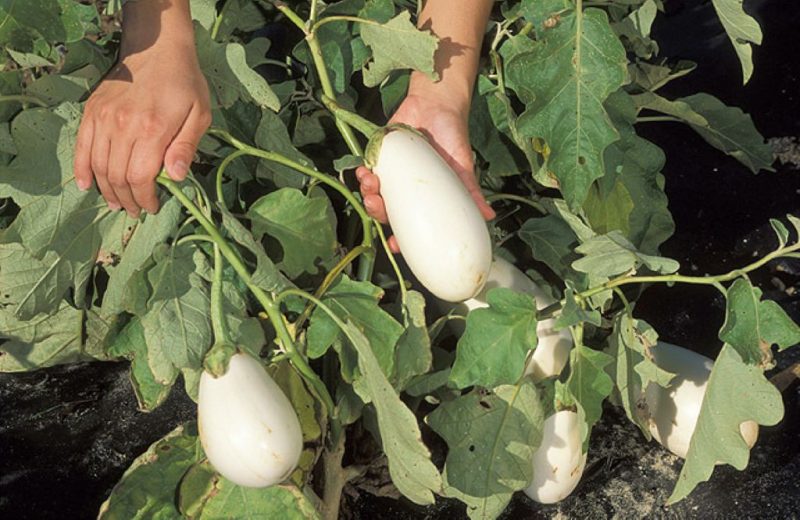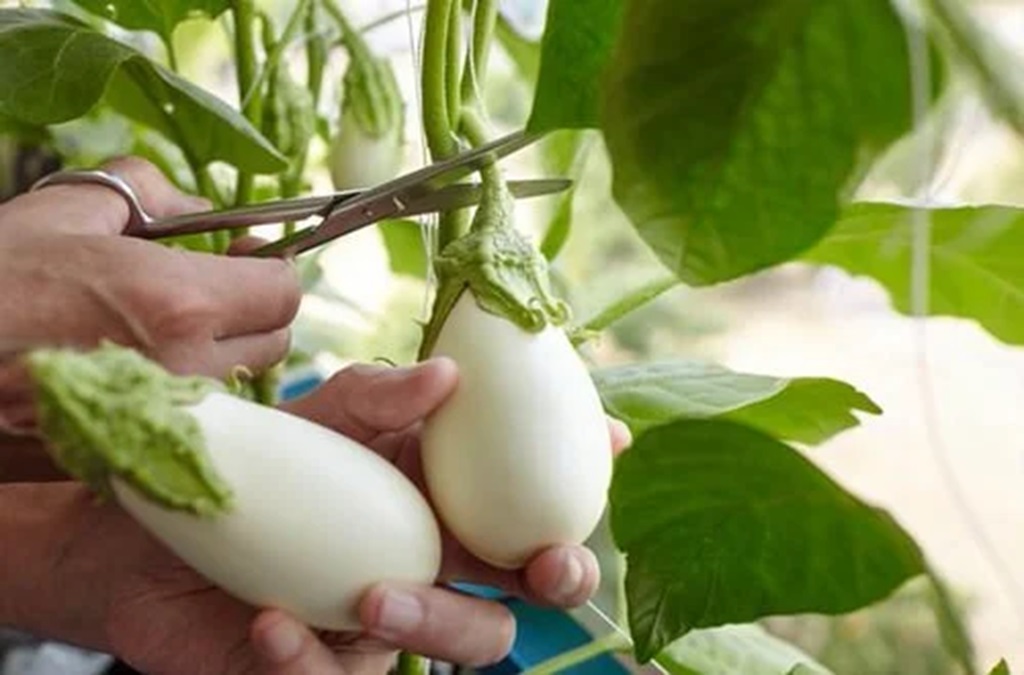White eggplants should be picked when they are still young and firm, typically around 3-4 inches long, and have shiny skin with no blemishes. White eggplants should be picked when young and healthy to ensure the best flavor and texture.
These eggplants are a versatile addition to any culinary repertoire, offering a mild, slightly sweet flavor that pairs well with various dishes. Whether grilled, roasted, or used in stir-fries, white eggplants can add a delightful twist to your meals.
We’ll explore the ideal timing for picking white eggplants to maximize their flavor and nutritional benefits. We’ll also discuss some tips on selecting and storing these unique vegetables to maximize their culinary potential.
Why White Eggplant?
When choosing eggplants, the white variety offers a unique and delicious option worth exploring. Known also as white auberges, these vegetables are often overshadowed by their more familiar purple counterparts. However, they present a distinct flavor and an array of nutritional benefits that make them an excellent addition to your culinary collection. Unlike the typical eggplant, white eggplants have a creamier texture and a milder, less bitter taste, making them a versatile ingredient in a variety of dishes.
Nutritionally, they are packed with fiber, vitamins, and minerals, supporting overall health. Additionally, their unique color and appearance can add an aesthetic appeal to meals, making your dishes not only tasty but also visually enticing. For those interested in expanding their garden or kitchen palette, white eggplants come highly recommended by experts and enthusiasts alike, including those at Hatchettgardendesign. Their nutritional and flavorful appeal makes them a standout choice for anyone looking to diversify their vegetable intake.
Nutritional Benefits
White eggplants are not only visually appealing but also pack a nutritional punch. They are low in calories and dietary fiber, making them an excellent choice for those seeking a healthy, balanced diet. These eggplants are also rich in essential nutrients such as vitamin C, K, and potassium, necessary for overall health.
Unique Flavor
White eggplants offer a uniquely mild and slightly sweet flavor compared to their purple counterparts. Their flesh tends to be less bitter and seedy, making them a versatile ingredient that can be used in various dishes. Whether roasted, grilled, or sautéed, white eggplants add a subtle and delicious flavor to any recipe.
Determining When To Pick White Eggplant
When picking white eggplant, it’s crucial to harvest them at their peak for optimal flavor and texture. The right time to pick a white eggplant is not just about the calendar date; it involves closely observing the appearance, color, size, and firmness of the fruit. A ripe white eggplant should have a glossy, smooth skin and a uniform creamy color. Size-wise, they should feel substantial but not overly large, as overly mature eggplants can become bitter and seedy. Firmness is another key indicator; the fruit should be firm yet give slightly under pressure, indicating it’s ready to be enjoyed. Understanding these indicators ensures that your white eggplant seeds yield the best possible produce for your culinary creations. By paying attention to these details, you can ensure that your white eggplants are harvested at the perfect stage of ripeness, enhancing the taste and texture of your dishes.
Appearance And Color
White eggplants are ready to be picked when their skin becomes glossy and creamy white. Avoid harvesting them while the skin is still pale or dull-looking. The fruit should be consistently white all over without any hint of browning or discoloration, indicating that it is at its peak ripeness.
Size And Firmness
When determining the optimal time to pick white eggplant, it is essential to consider their size and firmness. Choose medium to large fruits, typically around 6 to 8 inches long and 2 to 3 inches in diameter. Additionally, the eggplant should feel firm to the touch, indicating that it is sufficiently mature for picking.
Signs Of Overripe White Eggplant
Overripe white eggplants can be identified by their yellowish color, dull skin, and soft texture. It is best to pick white eggplants with a firm and glossy sheen, indicating they are ripe and ready to be harvested.
Yellowing Skin
When picking white eggplant, yellowing skin is one of the main signs of over ripeness. If you notice that the skin of the eggplant has turned from a glossy white to a dull yellow color, it is a clear indication that the vegetable has become overripe. The yellowing of the skin happens as the eggplant continues to mature and loses its freshness. An overripe white eggplant with yellow skin will have a bitter taste and a softer texture that may not be desirable for consumption. Therefore, checking for this specific characteristic before selecting white eggplants for your recipes is essential.
Softness Of Flesh
Another noticeable sign of an overripe white eggplant is the softness of its flesh. When gently pressed, a ripe white eggplant should have a firm and slightly springy texture. However, once it starts to become overripe, the flesh will become increasingly soft.
If you press the eggplant and your fingers leave an indentation, the fruit has become too ripe to be consumed. The soft flesh results from the breakdown of cell walls within the eggplant, which affects its taste and overall quality. So, check for firmness when selecting white eggplants to ensure you get the freshest and most flavorful ones.
In conclusion, identifying the signs of overripe white eggplant is crucial for selecting the best quality fruits. Please pay attention to the yellowing skin and the softness of the flesh to avoid purchasing eggplants that have lost their freshness. You can enjoy white eggplants at their peak flavor and optimum texture by being mindful of these indicators. So, watch for these signs when you are ready to pick some delicious white eggplant for your next culinary creation.
Timing The Harvest
When it comes to harvesting white eggplant, timing is crucial. Picking the eggplant at the right moment ensures optimal flavor and texture. But how do you know when it’s time to harvest? In this article, we will explore the ins and outs of timing the white eggplant harvest, providing valuable tips to ensure a bountiful and delicious harvest.
Checking Maturity
Checking the maturity of the white eggplant is crucial in determining when it is ready for harvest. There are a few indicators to look out for:
- Fruit Size: A mature white eggplant typically reaches around 4 to 6 inches. If your eggplant is this size, it’s a good indication that it’s ready to be picked.
- Firmness: Gently press the eggplant with your fingers. If it feels firm but not hard, it’s likely at its peak ripeness.
- Skin Color: White eggplants should have glossy, creamy white skin. If the skin appears dull or discolored, it may be a sign that the eggplant is overripe.
Using The Thumbnail Test
The thumbnail test is a simple and effective way to determine if your white eggplant is ready for harvest. Here’s how to do it:
- Press your thumbnail against the skin of the eggplant.
- If the skin springs back, the eggplant is not yet mature enough for harvesting.
- However, if the skin does not spring back and leaves a slight indentation, it’s a clear sign that the eggplant is at its peak ripeness and ready to be picked.
Using this handy thumbnail test, you can be confident in your decision to harvest your white eggplant at the optimal time.
Harvesting Techniques
Look for a glossy sheen and firm texture to determine the best time to harvest white eggplants. Gently squeeze the eggplant to check for tenderness, and cut it from the vine using a sharp knife or shears. White eggplants are typically ready to pick around 65-80 days after planting when they reach their full size and firmness.
When it comes to picking white eggplant, timing is crucial. Proper harvesting techniques ensure you have firm and flavorful eggplants ready for your culinary creations. Let’s explore the essential steps you should follow to harvest white eggplant successfully.
Trimming The Stem
To begin harvesting, gently hold the white eggplant in one hand while using a sharp pair of garden shears or a knife in the other hand. Locate the fruit stem and cut it off, leaving about an inch attached to the eggplant. This prevents premature spoilage and helps extend the shelf life of your harvest.
Avoiding Bruising
White eggplants are delicate and can easily be damaged during harvesting. Handle them with care to avoid bruising and prevent any significant damage to your eggplants. Support the fruit with one hand while gently twisting it away from the stem. Avoid squeezing the eggplant, as this can lead to unsightly bruises and affect the fruit’s overall quality.
Storing Properly
After harvesting, storing your white eggplants properly is crucial to maintain their freshness for as long as possible. Ensure you place the harvested eggplants in a cool and dry location away from direct sunlight. Storing them at a temperature around 50°F (10°C) and with a relative humidity of 85-95% will help preserve their quality. Remember to keep the eggplants away from other fruits and vegetables, as some varieties release ethylene gas, which can accelerate spoilage.
Inspecting For Ripeness
Before picking your white eggplants, ensuring they have reached the optimal level of ripeness is essential. A ripe white eggplant will have a glossy, smooth skin and feel firm to the touch. Avoid harvesting eggplants with a dull appearance or a wrinkled texture, as they may be overripe or past their prime. It’s always best to harvest eggplants at their peak flavor and texture.
Harvesting Regularly
To encourage continuous growth and maximize your white eggplant harvest, it’s essential to pick your eggplant regularly. Harvesting every few days encourages new fruit production and prevents the plant from becoming overcrowded. By removing ripe eggplants promptly, you allow the plant to focus its energy on producing more fruit, leading to a bountiful harvest throughout the growing season.
In conclusion, harvesting white eggplants requires careful attention to detail and proper techniques. Trimming the stem, avoiding bruising, and storing the harvested fruit correctly allows you to enjoy flavorful and delicious white eggplants in all your culinary creations. Don’t forget to inspect for ripeness and gather regularly to ensure a continuous supply of these unique and versatile vegetables.
Frequently Asked Questions For When To Pick White Eggplant
When Is The Best Time To Pick White Eggplant?
White eggplants are best picked when they reach a uniform ivory color and are firm to the touch. This usually occurs when they are around 4-6 inches in length. Harvesting them at this stage ensures optimal flavor and texture.
How Do I Know If A White Eggplant Is Ripe?
A ripe white eggplant will have a glossy, smooth skin and feel firm when gently squeezed. Avoid ones with blemishes or soft spots. Additionally, the color should be a uniform ivory shade. If the eggplant meets these criteria, it is likely ripe and ready to be picked.
Can I Pick White Eggplants Before They Are Fully Grown?
Yes, you can harvest white eggplants before they reach their full size. However, smaller eggplants may have a slightly milder taste compared to fully grown ones. If you prefer a more subtle flavor or are short on time, picking them earlier can still result in delicious dishes.
How Often Should I Pick White Eggplants?
White eggplants should be picked regularly, around every five to seven days. Regular harvesting encourages more fruit production and prevents the plants from becoming overcrowded. Check the plants often and pick the ripe eggplants to keep the plant healthy and ensure a continuous supply throughout the growing season.
Conclusion
Knowing when to pick white eggplant is crucial for enjoying its optimal taste and texture. Craving the Best Breakfast in Portland? Dive into Ultimate Morning Delights that promise a flavorful and satisfying culinary experience. By considering factors such as color, firmness, and size in selecting ripe white eggplants, you can elevate the flavors of Mediterranean recipes or any new dish, making your meal truly delightful.
Enjoy this unique and versatile vegetable during its peak season.




